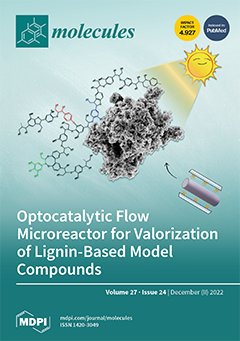Medicinal plants and herbal preparations are gaining attention in the scientific community today, as they are often used intermittently in the treatment of various diseases. The genus of
Polygonum (Polygonaceae), known locally as “madimak”, is an aromatic plant widely used in world flavors. The chemical composition of the essential oils of dried aerial parts of seven of
Polygonum was analyzed by GC-MS. These species are
Polygonum lapathifolium L.,
Polygonum persicaria L.,
Polygonum arenastrum Bor.,
Polygonum bellardii All.,
Polygonum arenarium Waldst. Et Kit.,
Polygonum aviculare L., and
Polygonum cognatum Meissn. Qualitative and quantitative differences were found in the essential oil analysis of the seven
Polygonum species. The major compounds were determined as (
E)-
β-farnesene (19. 46%), dodecanal (15.92%),
β-caryophyllene (12.95%), in
P. aviculare; (
E)-β-farnesene (25.00%), dodecanal (20.45%),
β-caryophyllene (9.38%), and caryophyllene oxide (8. 26%) in
P. persicaria; dodecanal (25.65%), caryophyllene oxide (13.35%),
β-caryophyllene (7.95%), and
(E)-β-farnesene (6.20%) in
P. lapathifolium, and dodecanal (19.65%), (E)-β-farnesene (13.86%),
β-caryophyllene (8.06%), and
α-terpineol (7.2%) in
P. arenarium, dodecanal (16.23%),
β-caryophyllene (16.09%), (
E)-β-farnesene (12.26%), caryophyllene oxide (7.94%) in
P. bellardii,
(E)-β-farnesene (20.75%), dodecanal (17.96%),
β-caryophyllene (13.01%),
α-terpineol (4.97%) in
P. arenastrum, (
E)-
β-farnesene (9.49%), dodecanal (14.01%),
β-caryophyllene (11.92%), geranyl acetate (9.49%), and undecanal (7.35%) in
P. cognatum. This study is the most comprehensive study conducted to determine the essential oil components of
Polygonum species. In addition, a literature review on the composition of the essential oils of these
Polygonum taxa was performed. The essential oil components of the species in our study were revealed for the first time with this study.
Full article






